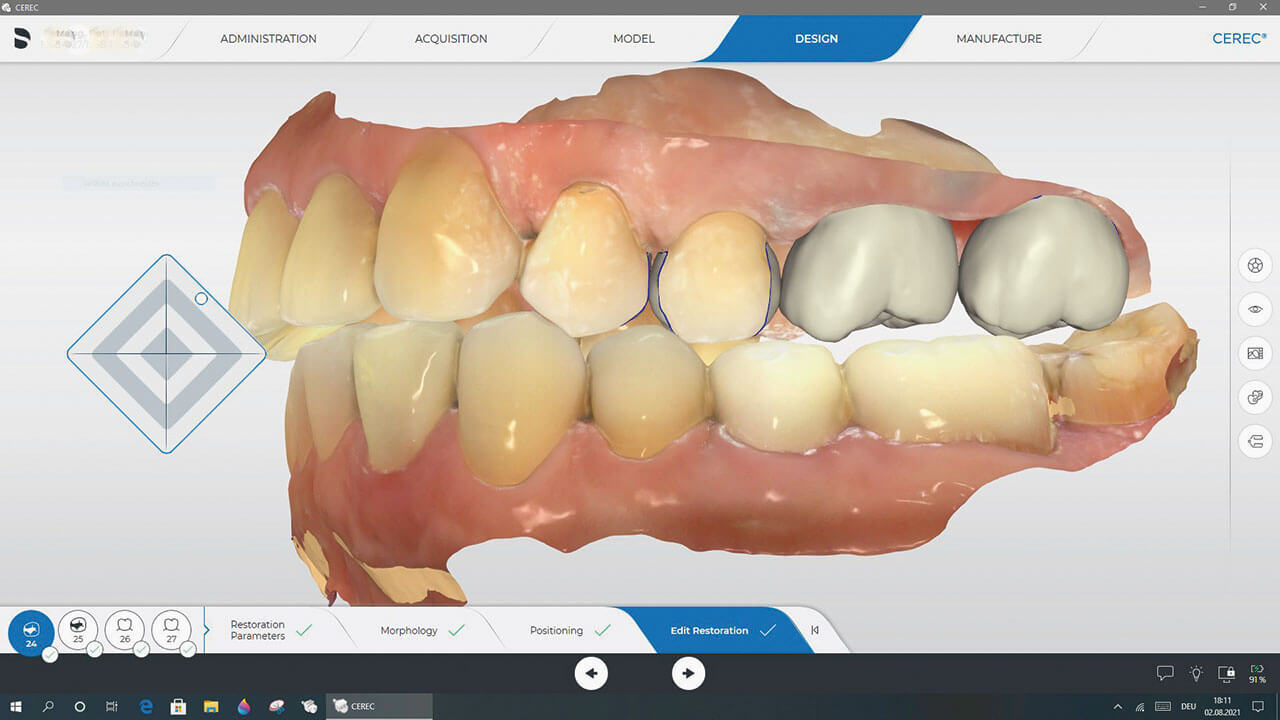The International Journal of Prosthodontics, 1/2023
DOI: 10.11607/ijp.7287, PubMed ID (PMID): 33751004Pages 7-12, Language: EnglishPala, Kevser / Bindl, Andreas / Mühlemann, Sven / Özcan, Mutlu / Hüsler, Jürg / Ioannidis, AlexisPurpose: To evaluate the minimum ceramic thickness needed to increase the lightness by one value by means of glass-ceramic restorations, as perceived by dental technicians, dentists, and laypersons.
Materials and Methods: A total of 15 assessment pairs (= reference and test sample) were formed using glass-ceramic blocks in four different colors. Each assessment pair was comprised of two underground blocks differing by one value of lightness. On top of the underground blocks, glass-ceramic platelets were cemented in 5 different thicknesses (0.1 to 0.5 mm) in the same color as the reference. Dental technicians, dentists, and laypersons (n = 41/group) were asked to determine the presence of a color difference between the two samples under standardized light conditions. The threshold ceramic thickness was defined as the thickness at which ≥ 50% of the evaluators were not able to perceive a difference within an assessment pair. The thresholds were analyzed, and groups were compared by applying chi-square test (P < .05).
Results: The majority of dentists and dental technicians (> 50%) detected a lightness difference between test and reference samples up to a ceramic thickness of 0.5 mm. The majority of laypersons (≥ 50%) did not perceive lightness differences with ceramic thicknesses of 0.5 mm. If separated by the different color changes, the threshold ceramic thickness started at 0.4 mm and varied within the groups of evaluators and the lightness of the assessed color.
Conclusions: A considerable number of evaluators perceived a lightness difference when minimally invasive ceramic restorations of 0.5-mm thickness were applied. The threshold ceramic thickness, however, was reduced when the lightness of the substrate was lower.
International Journal of Computerized Dentistry, 4/2021
ApplicationPubMed ID (PMID): 34931778Pages 429-438, Language: English, GermanBindl, AndreasThe significantly faster fabrication technique of chairside restorations with the aid of the Cerec Primemill milling unit makes it possible to restore an entire quadrant in a reasonable amount of time. Furthermore, the procedure described in this article made it possible to use a new type of medium-strength ceramic that achieved a very good esthetic result overall.
Keywords: Cerec CAD/CAM Chairside, inlays, crowns, CAD/CAM chairside materials
International Journal of Computerized Dentistry, 2/2017
PubMed ID (PMID): 28630954Pages 119-120, Language: English, GermanBindl, AndreasInternational Journal of Computerized Dentistry, 4/2015
PubMed ID (PMID): 26734666Pages 319-331, Language: English, GermanMaggetti, Ivano / Bindl, Andreas / Mehl, AlbertObjectives: To address the controversy, in which indications average value articulation is suitable or to what extent individual registrations, especially using the facebow, should be applied, a quantification of the variability of relevant anatomical landmarks is necessary. The goal of this study was to investigate the mean and natural bandwidth of the parameters describing articulation.
Methods: Significant landmarks were measured on three-dimensional (3D) cone beam computed tomography (CBCT) scans of 120 arbitrarily selected individuals. The bandwidth and mean values of the anatomical relations were calculated.
Results: The mean arm length of the Bonwill triangle was 103.3 mm, with a range of 90.2 mm (minimum) to 117.9 mm (maximum), and a mean base length of 99.6 mm, with a range of 85.2 mm to 112.6 mm. There was a high correlation between the length of the left and right arms, but not between the arms and the base. The mean height of the Bonwill triangle, measured between the condyles and the occlusal plane, resulted in 34.3 mm, with a range of 21.0 mm to 47.2 mm. The mean value of the Balkwill angle was 20.4 degrees, with a range of 9.0 degrees to 27.6 degrees. The angle between the Camper's line and the occlusal plane averaged around 7 degrees.
Conclusions: This study presents the bandwidth of anatomical relations necessary for articulation systems. The results are specific for males and females. The relevant parameters offer a high symmetry between the right and left sides. Additionally, the results show that the Bonwill triangle is more likely to be isosceles than equilateral.
Clinical significance: The knowledge of the anatomical bandwidth of temporomandibular joint (TMJ) positions in relation to the dentition allows the simulation of software- controlled virtual articulators and the substitution of facebows.
Keywords: Bonwill triangle, anatomical landmarks, Camper's plane, articulator, occlusal plane
International Journal of Computerized Dentistry, 2/2015
PubMed ID (PMID): 26110928Pages 163-175, Language: English, GermanBindl, AndreasIt is now possible to produce full-digital drilling templates with Cerec Guide 2 (Sirona) in the dental practice relatively quickly, efficiently, and economically. Here, a patient case example is used to present an exemplary description of the procedure and method to do this. The solution described herein shows the advantageous efficiency, compared with other systems presently on the market, of a procedure that does not require the external production of the drilling template in the laboratory or a manufacturing center.
Keywords: CAD/CAM, Cerec, chairside, cone beam computed tomography, implant planning/prosthetic planning, surgical guides
Quintessence International, 2/2015
DOI: 10.3290/j.qi.a32634, PubMed ID (PMID): 25191670Pages 97-108, Language: EnglishSchmidlin, Patrick R. / Stawarczyk, Bogna / DeAbreu, Danielle / Bindl, Andreas / Ender, Andreas / Ichim, Ionut P.Objective: To evaluate the fracture resistance and failure types of modified H-designed intradental short retention preparation for computer-aided design/computer-assisted manufacture (CAD/CAM) restorations, in cases where no ferrule is possible.
Method and Materials: A combined finite element analysis and in vitro testing was employed. Forty extracted single-rooted premolars were selected and prepared for the following four groups (n = 10 per group): Group A, H-post preparation restored with glass-ceramic crowns; group B, H-post preparation restored with lithium disilicate crowns; group C, endocrowns (negative control group); and group D, 2-mm ferrule preparation and restoration with fiber posts (positive control). After cementation, specimens were loaded to fracture (1 mm/min) in a universal testing machine. The data were analyzed using Kolmogorov-Smirnov, Shapiro-Wilk test, one-way ANOVA, followed by post-hoc Scheffé test and chisquare test.
Results: The H-post group restored with lithium disilicate crowns (group B) presented higher fracture resistance compared to the H-post group with glass-ceramic crowns (group A) and the endocrowns (group C). Among the failure analysis, only specimens of group C were all repairable after fracture load test, while the specimens of remaining groups A, B, and D accounted for 90%, 70%, and 50% repairable fracture modes, respectively.
Conclusion: The modification of the short intracoronal restoration anchorage profile may be a valid concept to improve the retention and fracture resistance, given that the materials are adjusted for this purpose in terms of mechanical resistance and internal adaptation. Numerical evaluations and future in vitro studies may help to select the best designs and materials.
Keywords: bonding, CAD/CAM, ceramic, failure types, finite element analysis, fracture resistance
Quintessence International, 10/2015
DOI: 10.3290/j.qi.a34701, PubMed ID (PMID): 26345100Pages 871-880, Language: EnglishGrohmann, Philipp / Bindl, Andreas / Hämmerle, Christoph / Mehl, Albert / Sailer, IrenaObjective: The aim of this multicenter randomized controlled clinical trial was to test posterior zirconia-ceramic fixed dental prostheses (FDPs) veneered with a computer-aided design/computer- assisted manufacture (CAD/CAM) lithium disilicate veneering ceramic (CAD-on) and manually layered zirconia veneering ceramic with respect to survival of the FDPs, and technical and biologic outcomes.
Method and Materials: Sixty patients in need of one posterior three-unit FDP were included. The zirconia frameworks were produced with a CAD/CAM system (Cerec inLab 3D/Cerec inEOS inLab). Thirty FDPs were veneered with a CAD/CAM lithium disilicate veneering ceramic (Cad-on) (test) and 30 were veneered with a layered zirconia veneering ceramic (control). For the clinical evaluation at baseline, 6, and 12 months, the United States Public Health Service (USPHS) criteria were used. The biologic outcome was judged by comparing the plaque control record (PCR), bleeding on probing (BOP), and probing pocket depth (PPD). Data were statistically analyzed.
Results: Fifty-six patients were examined at a mean follow-up of 13.9 months. At the 1-year follow-up the survival rate was 100% in the test and in the control group. No significant differences of the technical outcomes occurred. Major chipping occurred in the control group (n = 3) and predominantly minor chipping in the test group (minor n = 2, major n = 1). No biologic problems or differences were found.
Conclusions: Both types of zirconia-ceramic FDPs exhibited very good clinical outcomes without differences between groups. Chipping occurred in both types of FDPs at small amounts, yet the extension of the chippings differed. The test FDPs predominantly exhibited minor chipping, the control FDPs major chipping.
Keywords: CAD/CAM, CAD-on, fixed dental prosthesis, lithium disilicate, zirconia
International Journal of Computerized Dentistry, 2/2014
PubMed ID (PMID): 25098157Pages 95-96, Language: English, GermanBindl, AndreasInternational Journal of Computerized Dentistry, 2/2014
PubMed ID (PMID): 25098159Pages 115-124, Language: English, GermanRitter, Lutz / Palmer, J. / Bindl, Andreas / Irsen, Stefan / Cizek, Jirka / Karapetian, Viktor-E. / Zöller, Joachim E.Purpose: To describe a chairside method for producing implant guides based solely on digital data and present a first assessment of in vitro accuracy on plaster models.
Material and Methods: Twenty-four implants were planned and pilot drillings were performed according to a new protocol, which is based on the registration of CBCT and CAD/CAM data. Chairside-milled one-piece drill guides were used to transfer the virtual plan into reality. Accuracy measurements were acquired.
Results: Chairside-milled drill guides were successfully fabricated and accuracy for pilot drillings was between 0.17 and 1.3 mm.
Conclusion: Within the limits of this experimental study, chairside-milled drill guides are feasible and do not require any preparation before CBCT scanning.
Keywords: accuracy, dental implantology, cone-beam computed tomography (CBCT), dental CAD/CAM, computer-aided surgery (CAS), drill template, surgical guides
The International Journal of Prosthodontics, 2/2014
DOI: 10.11607/ijp.3514, PubMed ID (PMID): 24596916Pages 165-168, Language: EnglishRonay, Valerie / Bindl, Andreas / Sahrmann, Philipp / Schmidlin, Patrick R.Purpose: To describe the survival, clinical rating, and patient satisfaction of monolithic computer-aided design/computer-assisted manufacture (CAD/CAM) ceramic singleunit cantilever crowns placed on hemisected molars and premolars after a follow-up of at least 12 months.
Materials and Methods: Sixteen consecutive patients (mean age, 56.8 years) with 16 restored two-unit cantilever crowns (5 premolars and 11 hemisected molar abutments) were reevaluated after an observation period of at least 12 months. Tooth mobility, plaque and bleeding scores, and pocket probing depths were assessed on both the restored and contralateral untreated teeth. Patient satisfaction was evaluated using a visual analog scale.
Results: The mean observation time was 25.7 ± 13.1 months. All restorations were in situ, and no significant biologic differences were observed between the treated and contralateral teeth. Clinical evaluation showed good performance, and patient satisfaction was recorded as excellent.
Conclusion: The use of CAD/CAM ceramic single-unit cantilever crowns may be regarded as a conservative and cost-effective treatment modality with high patient acceptance in carefully selected patients. Int J Prosthodont 2014;27:165-168. doi: 10.11607/ijp.3514







